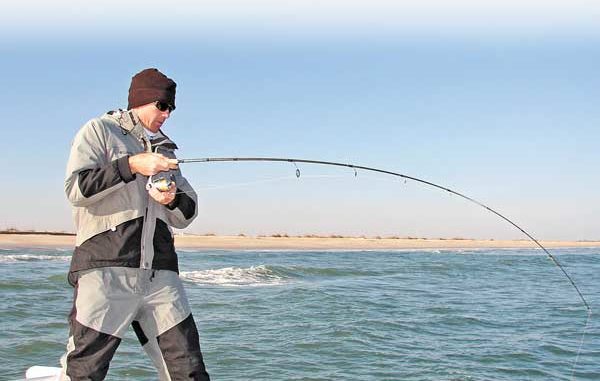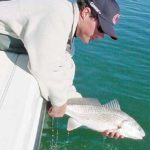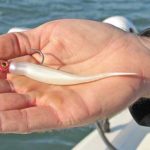
Early spring fishing just off deserted beaches will make anglers dance.
Gloves, ski masks and heavy coats were the order of the day as Capt. Stuart Caulder zipped out of Masonboro Inlet and headed up the beach to look for schools of redfish feeding in the late winter surf.
Caulder pushed the throttle well forward on his Suzuki-powered Triton bay boat and soon, he was speeding past Wrightsville Beach, Shell Island and Figure Eight Island, on the way to Rich Inlet and undeveloped Lea and Hutaff Islands that range up the coast to New Topsail Inlet.
Once he reached Rich Inlet, Caulder throttled back and eased toward the beach, stopping just offshore of the outer sandbar. The mid-morning start directed by Caulder had nothing to do with warming up — though it helped. He was waiting for the sun to reach a point high enough in the sky that it would penetrate the water’s surface and help him spot the schools of redfish that feed along the ocean beach.
“Concentrations of baitfish, birds diving in the surf, a school of porpoises right in the surf and just about any oddities in the water could be a sign of a school of reds,” said Caulder, who runs Gold Leader Guide Service (910-686-9768). “I usually find them by looking at the waves right along the beach. When a wave rolls up, you can see them swimming through it. They look a lot like a school of mullet, but this time of year, it’s reds. Some of the schools may be smaller, but most will be several hundred fish, and they are usually pretty easy to spot when we have conditions like this.”
Roughly a quarter-mile up the beach, Caulder quickly turned and dropped the boat off plane. He began to point excitedly to a spot a mere handful yards from shore. At first, the spot just looked a little darker, but when the next small wave rolled through, fish appeared in the swell.
“Look, there they are,” Caulder said in a hoarse half-whisper. “You saw that didn’t you? I’m going to hold us out here for a minute while we get everything ready. When we’re ready, I’ll move us in and have y’all cast. Once you’re hooked up, just sit down, and I’ll shift into reverse until we’re back out to about six feet of water. Then we’ll stop and you can land your fish while this offshore wind holds us off the beach and out of the surf.
“Don’t cast into the middle of the school; concentrate on fishing the edges” Caulder said. “They usually aren’t too spooky out here in the ocean, but we don’t need to hook one in the middle of the school and have him rile all of them up during the fight. If you cast to the edges, we should be able to fish this school until we’re tired. I’ve set the drags a little loose so you won’t pull on them too hard while we back out to deeper water. Get ready; this is going to be fun.”
Caulder had rods rigged with 4-inch, white D.O.A. C.A.L. jerkbaits on quarter-ounce jigheads. He cautioned that the water was pretty cool, and the reds weren’t moving quickly, so slow retrieves, with the lures bumping along the bottom, would be most productive. He explained that this action resembled an injured baitfish and would help tempt the reds into biting.
Caulder was absolutely correct, too. That first school of fish was already feeding and pounced on the lures without hesitation. Casts directed to the edge of the disturbed spot of water, plus a few twitches of the rod tip, resulted in the first two bites.
The water was shallow, and both fish made huge rolls as soon as they felt the hooks. Even though it was a pair of reds whose first moves were nearly identical, this was nothing like synchronized swimming — it was much more fun and exciting, complete with buzzing reels.
Their next moves were surges down the beach, away from the school. Once Caulder realized both fish were well connected, he clicked the outboard into reverse to ease the boat out to the deeper (and safer) water beyond the outside bar. The redfish didn’t want to be out that deep and struggled to move back toward the beach. It took a while, but eventually, both were led to a waiting landing net.
The encounter produced several more redfish from the first school before Caulder moved away to locate other schools. Most of the other schools were not feeding as aggressively and had to be coaxed into biting. Several times, Caulder gave instructions to try and keep the lures still, just twitching the rod tip so only their tails moved. That was enough to coax fish in each school to bite.
A few speckled trout also crashed the party. They weren’t in the shallows along the beach with the reds, typically holding off the bar, near the deepest part of the slough. Several times when only one red drum was hooked, Caulder moved the boat to deeper water, instructed the other fisherman to keep fishing, and that tactic resulted in hook-ups with specks. Although the trout readily hit the white jerkbaits and red/white jigheads, he said that he often switches to a grub with a green back when targeting specks.
The wind switched to onshore in the mid-afternoon and while it was nice to have the breeze a few degrees warmer, it was just enough to create some chop along the beach. The problem with the chop wasn’t catching fish, it was finding them. The chop rippled up the water and made it difficult to see the fish in the swells. The fish were still there and willing to bite, but they became much more difficult to locate.
Caulder was on a school of fish when the wind breezed up, and he stayed to catch a few more. But with visibility quickly deteriorating, he decided to call it a day.
The redfish beach boogie kept us hooked up with amazing frequency. The best moves might have been a couple of casting-deck 2-steps as fishermen danced around to keep from tangling lines when fish made runs in the same direction.








Be the first to comment